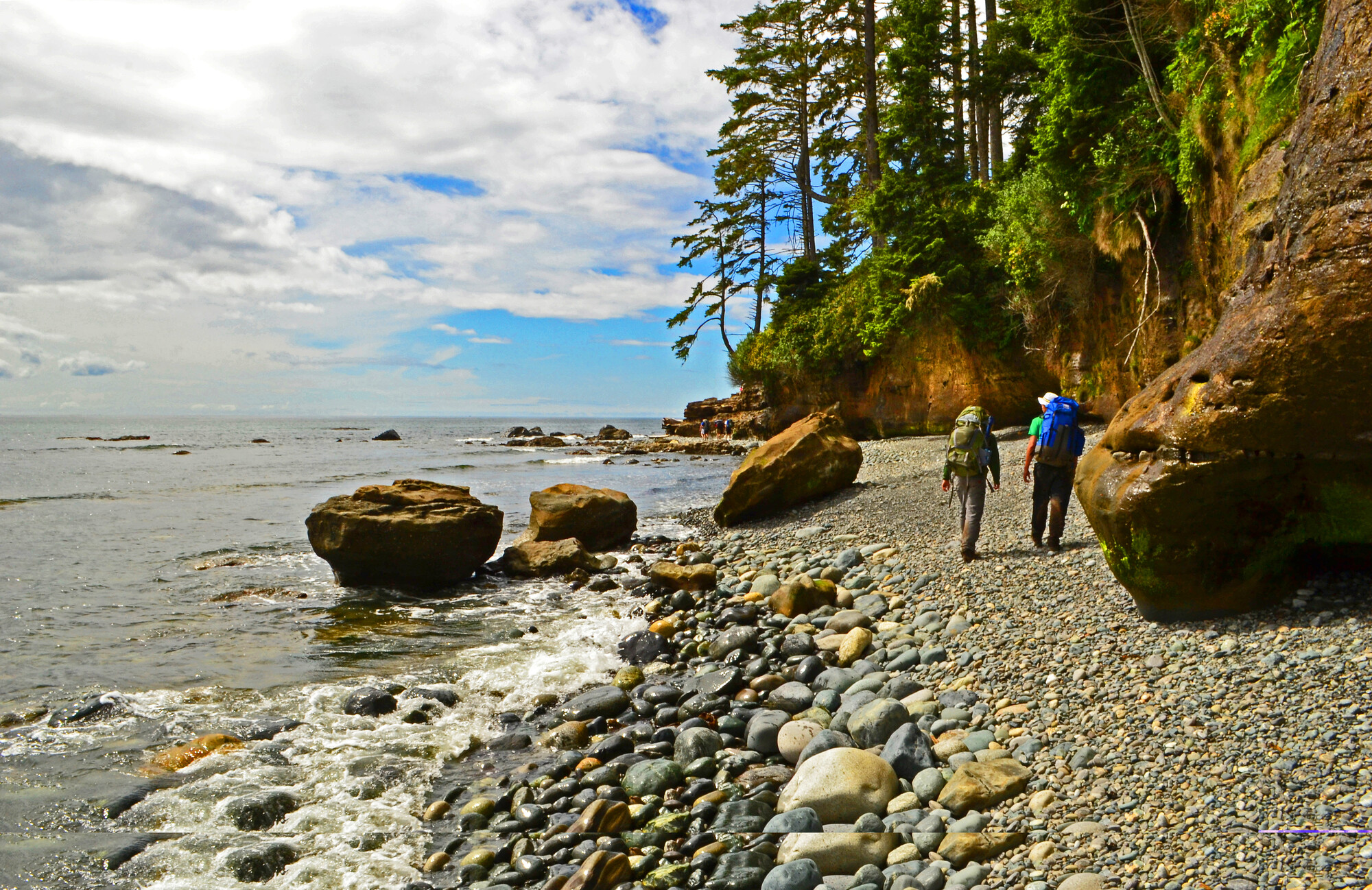China Beach
China Beach day-use area is a spectacular spot for family outings and day trips. The China Beach campground is a separate facility, located in a forested area with open understory just east of the China Beach day-use area and Juan de Fuca East trailhead.
Second Beach is reached from a 1 km trail down from the campsite via stairs and a fairly steep gravel trail. The 15-20 minute hike (each way) through the mature forest of Sitka spruce, Douglas fir and Western red cedar leads visitors to the great rolling breakers of a tumultuous sea.
China Beach campground
The China Beach campground is adjacent to Highway 14, just east of the China Beach day-use, 35 km west of Sooke and 36 km east of Port Renfrew.
There are 78 drive-in campsites available at this campground.
Reservations
Campsite reservations are required during the spring and summer camping seasons. Outside of this reservable window, the China Beach campground operates as first-come, first-served until the campground closes for the winter season.
Facilities and activities
- No facilities that are wheelchair-accessible
- No shower facilities
- No sani-station/dump facilities
- No cycling on park trails; cycling is permitted on the campground road network only
Pets and wildlife
Remember this is a wilderness area - black bears and cougars may be present. As a precaution, it is recommended that you leave pets at home.
China Beach day-use area
The fine sand beach is ideal for picnicking, sandcastle building, wading and relaxing. Pack a lunch and your drinking water and please remember that fires are not permitted on the beach.
Take a short walk to the western end of the beach to the waterfall or wander at length to the east. It is possible to walk along the beach between China Beach and Second Beach. Please respect the delicate vegetation and natural and cultural features of this park.
In the spring and fall, look for the magnificent grey whale offshore as it travels along its migratory route. As many as 17,000 of these mammoth creatures travel down the coast throughout the migration period; some, in fact, spend the summer off the shores of Vancouver Island.
Juan de Fuca East Trailhead (China Beach)
Located at Kilometre 0, the Juan de Fuca East Trailhead is the eastern terminus of the Juan de Fuca Marine Trail. From here visitors can either start the 47 km hike or take a 2.5 km day trip to beautiful Mystic Beach.
Sombrio Beach
Located at approximately Kilometre 29 of the Juan de Fuca Marine Trail, the large cobbled Sombrio Beach can be reached via a 250-metre access trail from the Sombrio Beach Trailhead parking lot, off Hwy 14. There are three designated wilderness camping areas at Sombrio Beach; East Sombrio, Main Sombrio and West Sombrio.
Visitors can explore or hike east or west along the beach, enjoy a picnic or try their hand at surfing in this world-class surfing area. Sombrio Beach is part of the Juan de Fuca Marine Trail, so please respect trail hikers.
Parkinson Creek is approximately 9 km west of Sombrio Beach; the nearest trailhead to the east is the Juan de Fuca East (China Beach) Trailhead at Kilometre 0.
Parkinson Creek
Parkinson Creek Trailhead is located at Kilometre 37.6 of the Juan de Fuca Marine Trail. From here you can hike east to Sombrio or west to Botanical Beach. There are 2 campsites nearby: Payzant Creek at Kilometre 40 and Little Kuitsche Creek at Kilometre 33.5.
This moderate section of trail takes hikers through regenerating logged areas and old growth forest fringe and along the beautiful rugged shoreline. Watch for marine mammals that frequent this area.
Botanical Beach
The Botanical Beach parking lot is the western terminus of the Juan de Fuca Marine Trail, located at Kilometre 47. This parking lot provides access to nearby Botany Bay and Botanical Beach itself.
Botanical Beach affords visitors with access to uniquely rich tide pools and shoreline trails with fantastic geological features. The extensive variety of marine flora and fauna in this colourful intertidal zone includes red, purple and orange starfish and sea urchins, white gooseneck barnacles, blue mussels and green sea anemones and sea cucumbers. Coralline algae, periwinkles, chitons and sea stars can also be seen at Botanical Beach.
The region is so biologically significant that the University of Minnesota installed the first marine research station in the Pacific Northwest at Botanical Beach in 1901. Since then, the area has been used for research by a number of universities in BC and Washington.
A low tide of 1.2 metres or less is best for viewing these tide pools. Use Canadian Tide Tables “Port Renfrew” section. Remember to add one hour to the listed tidal times during May to October as Daylight Savings Time is in effect.
Impact of human activity on the intertidal area is of growing concern. When visiting Botanical Beach, please look in the tide pools only – do not touch the marine life. Do not remove, collect or disturb any tide pool life, shells, plants, flowers, kelp, etc., as they are all part of a vulnerable ecosystem that Botanical Beach was established to protect. Even touching the water in a tide pool with sunscreen on your hands can create an “oil slick” that could kill the vulnerable creatures in this sensitive ecosystem. Photographs make great souvenirs.
The Botanical Beach day-use area offers parking, pit toilets, visitor information and picnic areas. While hiking on the trail, cars can be left overnight in the Botanical Beach parking lot. Please do not leave anything of value in your vehicle.
Please note that no camping or fires are allowed in this section of the park.
